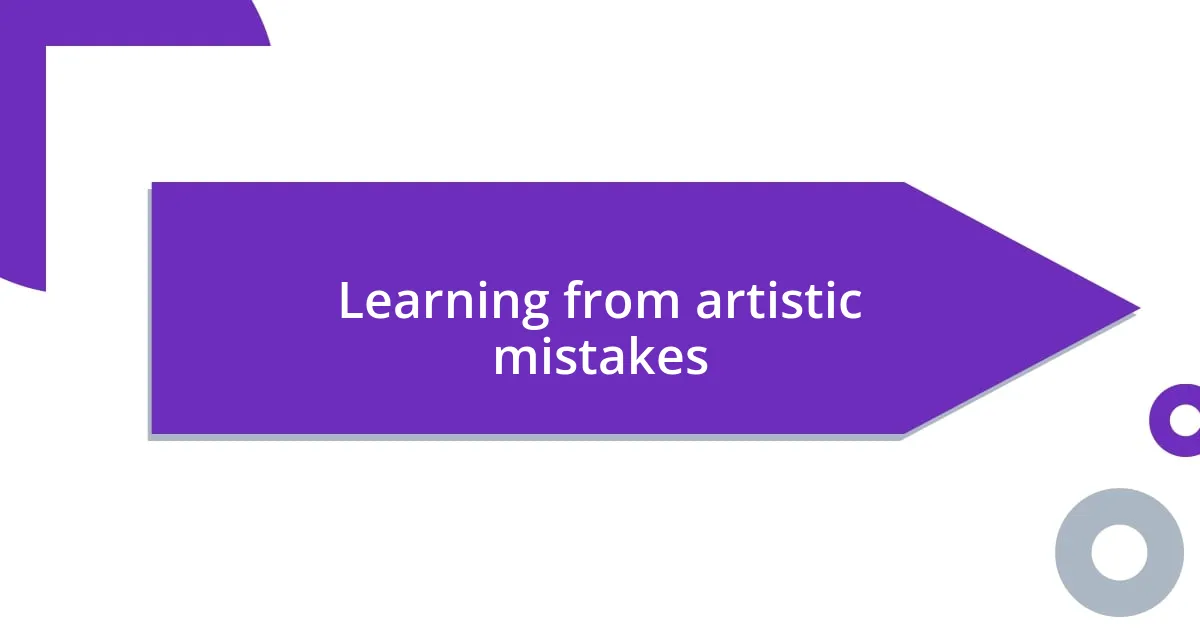Key takeaways:
- Failed portraits illustrate the gap between an artist’s vision and execution, highlighting the importance of technique and patience in art.
- Emotional responses to failures can lead to personal growth, resilience, and a deeper connection with the artistic community.
- Transforming failures into learning experiences fosters innovation and encourages the exploration of new techniques and mediums.
- Celebrating successes that arise from failures strengthens an artist’s confidence and commitment to continuous improvement.

What are failed portraits
Failed portraits can be seen as artwork that didn’t quite capture the essence of the subject. I remember a time when I attempted to paint a friend’s portrait; despite my best efforts, it turned out looking more like a cartoon character than the beautiful person I was trying to depict. Isn’t it fascinating how the intention behind a piece can sometimes get lost in translation?
These portraits often emerge from the tension between an artist’s vision and their execution. I once worked on a portrait that I thought would be a masterpiece, only to find it lacked the dynamism I had in mind. It made me wonder: how often do we become so attached to our vision that we overlook the reality of our skills?
Failed portraits serve as reminders that art is a journey, not just a destination. Each mishap teaches us something new—whether it’s about technique, perspective, or capturing emotion. I’ve learned to embrace these failures because they often lead to deeper understanding and unexpected creativity. How about you? Have any of your artistic trials taught you valuable lessons along the way?

Reasons for portrait failures
Sometimes, a lack of proper lighting can completely throw off a portrait. There was this one time when I was capturing a friend’s likeness outdoors, only for the sun to play tricks with shadows. The result was a face that seemed to be melting into the background—what a disappointment! It’s a stark reminder that what seems perfect in our minds doesn’t always translate to the canvas.
Another common pitfall is our overconfidence in our skills. I recall one project where I decided to experiment with a new technique without proper practice. The outcome was a jumbled mess, and my subject’s face looked nothing like them. This taught me that pushing boundaries is exciting, but it’s also crucial to have a solid foundation before diving into innovation.
Lastly, rushing through the process can lead to significant failures. I’ve been guilty of wanting to complete a portrait quickly, and my eagerness often resulted in overlooked details. I learned that patience is vital in art, revealing layers that a hurried hand can easily miss. Reflecting on these lessons, it became evident that the journey requires careful attention, compassion for the process, and respect for our artistic evolution.
| Reasons for Portrait Failures | Details |
|---|---|
| Lighting Issues | Can obscure details and distort features |
| Overconfidence | Leads to inadequate execution when trying new techniques |
| Rushing | Results in missed details and a lack of depth |

Emotional impact of failed portraits
The emotional impact of failed portraits can be profound. When I look back on my own experiences, I can feel the disappointment washing over me after pouring my heart into a piece that missed the mark. It’s like investing energy into a relationship that never quite connects—each failed attempt tugs at my self-esteem and stirs up insecurities about my artistic abilities. Yet, this same feeling has also prompted me to reflect, learn, and ultimately grow as an artist.
- Frustration: There’s an intense frustration that comes from knowing you didn’t achieve your vision.
- Self-Doubt: Each failure can lead to questioning your skills and choices, leaving you wondering if you’re cut out for art.
- Resilience: On the flip side, these moments can build resilience, pushing you to try again with fresh perspectives.
- Connection: Surprisingly, failed portraits sometimes resonate with viewers on a more emotional level; they see the struggle and authenticity in the work.
- Empathy: I’ve found that sharing my failures with others creates connections; it’s a reminder that we are all on a similar journey, grappling with our creative aspirations.

Learning from artistic mistakes
Learning from our artistic mistakes can truly spark growth in unexpected ways. For example, I once created a portrait that looked almost cartoonish instead of capturing the subject’s true essence. At first, I felt defeated, but after some reflection, I recognized how much I’d learned about proportions and facial structure. Isn’t it fascinating how failure can turn into a powerful teacher?
I remember another time when I tried to paint a complex background without really understanding color harmony. The end result was jarring and completely distracted from the portrait. I was disheartened, yet that experience highlighted the importance of holistic vision in art. Have you ever felt like a single mistake overshadowed your intention? It’s this realization that leads to stronger, more cohesive work in the future.
Through my journey, I’ve discovered that every failed piece holds valuable lessons. Each brushstroke that didn’t go as planned nudges me towards deeper insight. The emotional weight of these failures can feel heavy, but I’ve learned to embrace that discomfort. It often drives me to re-evaluate my approach and fuels my curiosity to experiment further. How could such emotional moments, then, be reframed as stepping stones rather than stumbling blocks?

Techniques to improve portrait skills
One of the most effective techniques I’ve found to improve my portrait skills is to study the structure of the human face. Early on, I remember being frustrated by my inability to capture likeness. It wasn’t until I spent hours sketching skulls and facial planes that everything clicked. Have you ever felt like a piece was almost there but just needed that structural framework? Understanding the underlying anatomy provides a roadmap for capturing unique characteristics and making the portrait feel alive.
Lighting can make or break a portrait. I recall a project where I relied heavily on harsh overhead light, which exaggerated shadows and flattened features. After that, I started experimenting with natural light—there’s this incredible softness in how it wraps around a subject. Don’t you agree that the right lighting can evoke such emotion? By paying attention to the quality and direction of light, I’ve been able to create portraits that not only look better but also tell a story. Mastering light is simply a game-changer.
Lastly, experimenting with different mediums has enriched my portrait work more than I expected. I used to be a one-medium artist, sticking strictly to oils, but when I ventured into pastels and even digital art, it opened up new creative avenues. It made me realize how each medium conveys emotion differently—pastels, with their softness, create a gentler portrayal. Have you thought about how changing tools might change your perspective? I’ve learned that embracing variety can elevate not only my skills but also my artistic voice.

Transforming failures into growth
Transforming my failures into growth has been a pivotal part of my artistic journey. I remember a particular piece where the colors seemed to clash rather than harmonize. Initially, I wanted to hide it away, but instead, I revisited it, examining what went wrong. This experience taught me that discomfort can be an excellent springboard for innovation. Have you ever learned something profound from a moment that felt like a disaster?
Recently, I had a landscape portrait that completely flopped because I ignored the importance of composition. The foreground was chaotic and overwhelming, utterly distracting from my subject. Rather than allowing myself to sulk, I took it as an opportunity to explore new compositional techniques. The next portrait I created incorporated those lessons, and I felt a sense of excitement as I applied more intentional placement of elements. Isn’t it incredible how mistakes pave the way for fresh ideas and approaches?
Embracing growth from failures isn’t always easy, but it’s been eye-opening. There are moments when I feel frustrated and want to give up, but then I look back at previous artworks that were less than ideal. They serve as reminders that each misstep has sharpened my creativity and resilience. How often do we think about the unexpected gifts failure can offer? I’ve come to find that while my journey may seem filled with bumps, each one has contributed to my evolution as an artist, and there’s beauty in that realization.

Celebrating success after failures
Although failures can be discouraging, I’ve found that they often lead me to celebrate my successes in unexpected ways. I vividly remember an instance when a portrait I created was met with disappointment; there was little response from my peers. Instead of throwing it aside, I decided to host a small gathering where I shared my struggles and sought constructive feedback. The insights I gained not only renewed my passion for that piece but also transformed my failures into a shared learning experience. Have you ever turned a moment of doubt into an opportunity for connection?
Looking back, I see that every misstep contributed to my sense of accomplishment. After completing a challenging project, I realized how much I had grown in my approach to color palettes. Once timidly mixing hues, I now feel empowered to experiment boldly, integrating lessons from past failures. I can recall the thrill of completing a portrait that felt truly authentic—it was like standing victorious after a challenging climb. Doesn’t that feeling of triumph after overcoming obstacles make every setback worth it?
Ultimately, each failure has given rise to new successes, often in ways I didn’t anticipate. There was a time when I utterly bombed a live painting event, but it led me to understand the value of preparation and confidence. Now, when I see my subsequent works gain recognition, I can’t help but smile, knowing that each piece is built upon those invaluable lessons. Can you think of a time when a setback motivated you to push even harder toward your goals? For me, these reflections illuminate a path filled with growth and renewed passion, reminding me that success often follows closely behind failure.














